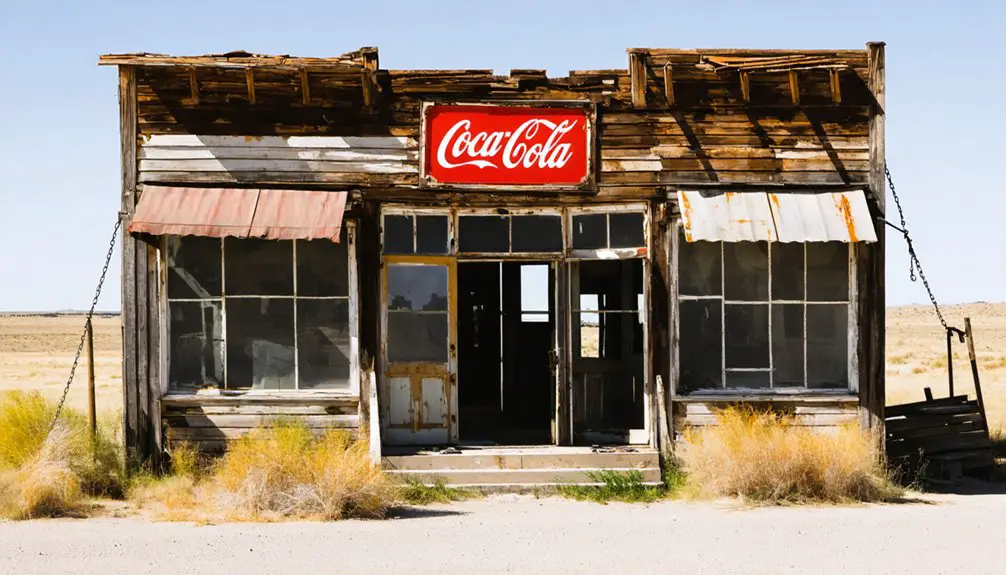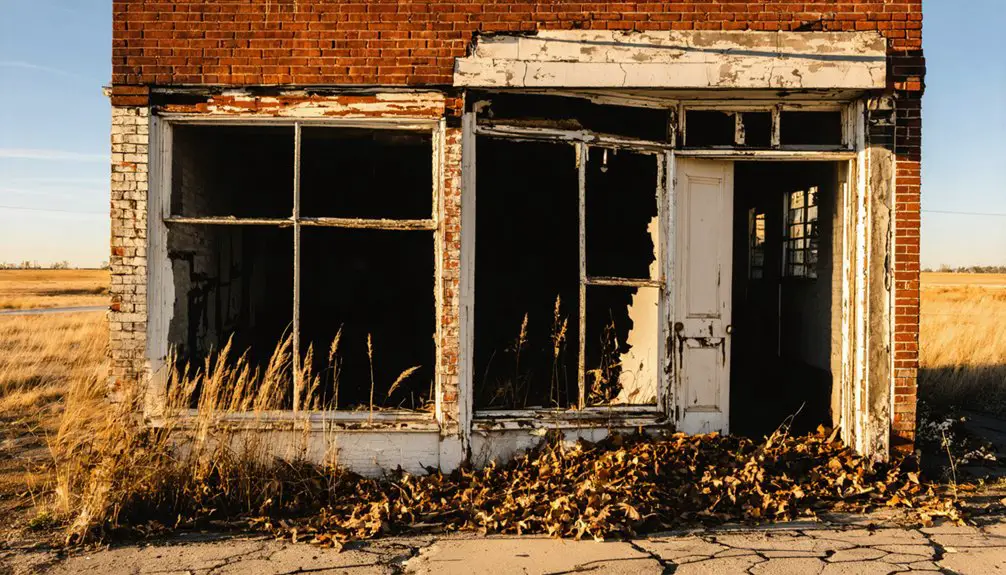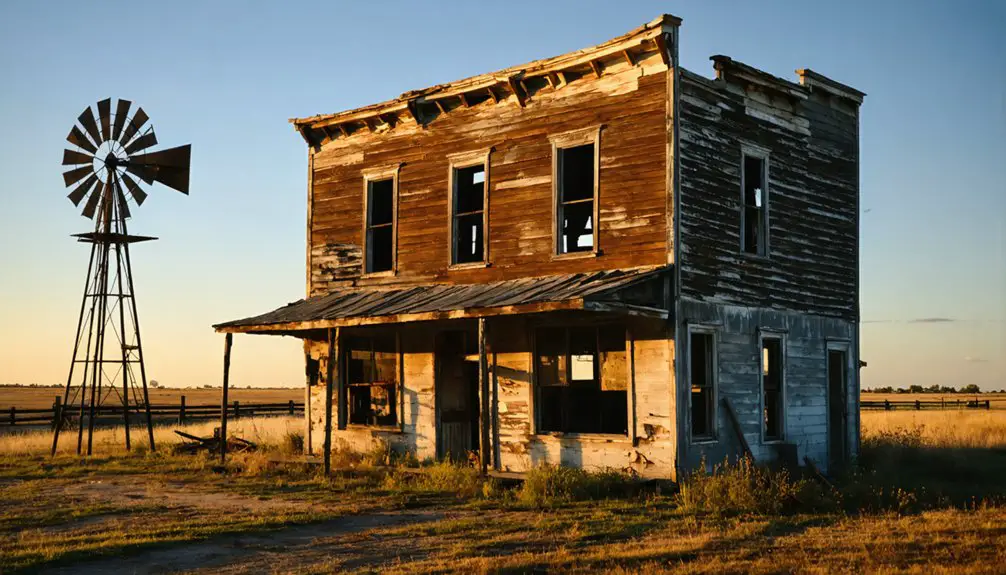You’ll find Humphreys, Oklahoma 7.5 miles southeast of Altus, where a once-thriving railroad town stood along the Missouri-Kansas-Texas (MKT) line. Founded in 1909 and named after rancher James Humphreys, this community flourished as an essential transportation hub until the Great Depression hit. Cotton prices plummeted, the Dust Bowl struck, and by 1961, even Humphreys Elementary had closed its doors. The town’s weathered remains hold stories of railroad glory days and countless untold tales.
Key Takeaways
- Humphreys began as a thriving railroad town in 1909 along the Missouri-Kansas-Texas Railroad, serving as a vital transportation hub.
- The Great Depression and Dust Bowl devastated the local farming community, forcing many residents to abandon their land.
- Post-WWII railroad realignments caused freight traffic to bypass Humphreys, leading to significant economic decline.
- The closure of Humphreys Elementary School in 1961 marked a turning point, as families left and community institutions disappeared.
- Today, Humphreys stands as a ghost town, with its legacy preserved through local families’ stories and historical records.
The Birth of a Railroad Town (1909)
As railroads expanded across Oklahoma Territory in the early 1900s, the small town of Humphreys emerged in 1909 along the Missouri-Kansas-Texas Railroad (MKT) line in southeast Jackson County.
You’ll find this town’s origins deeply rooted in the strategic railroad expansion that transformed Oklahoma’s landscape during this pivotal era.
Named after local rancher James Humphreys, the town’s location wasn’t random – it sat perfectly positioned about 7.5 miles southeast of Altus and six miles northeast of Tipton.
The town founding exemplified how railways shaped settlement patterns in the American Southwest. Unlike other Oklahoma communities built around farming or mining, Humphreys’ entire existence centered on servicing the railroad’s needs.
The MKT’s presence turned this once-empty stretch of ranch land into a bustling transportation hub, connecting the region to national markets. Like many place name disambiguations, the town shared its moniker with several other Humphreys locations across America. The railroad’s impact on commerce was significant, with freight charges decreasing dramatically compared to traditional wagon transport methods.
Life Along the Missouri-Kansas-Texas Line
If you’d stepped onto Humphreys’ bustling platform in the 1910s, you’d have witnessed freight handlers loading cotton bales and grain sacks while passengers hurried to catch the morning train to Muskogee.
The station’s daily rhythm brought together farmers hauling produce, traveling salesmen with sample cases, and local merchants awaiting supply shipments from Kansas City and Dallas.
Your visit would have revealed how the M-K-T line transformed Humphreys from a quiet crossing into a crucial hub where Native American traders, European immigrants, and Oklahoma settlers conducted business beneath the water tower’s shadow.
Much like the modern Texas Transportation Museum at 11731 Wetmore Road, Humphreys station served as a vital transportation center for its era.
On July 14, 1892, the infamous Dalton Gang struck fear into the hearts of passengers and railroad workers with their daring robbery at nearby Adair.
Railroad Creates Community Growth
When the Missouri-Kansas-Texas Railroad (MKT) laid its tracks through Indian Territory in the early 1870s, it sparked unprecedented growth along its route from Kansas to Texas.
You’d have witnessed the railroad’s significance as it transformed empty prairies into bustling communities, with towns springing up near every station. The MKT’s presence drew foreign investments, primarily from German and Dutch financiers, fueling rapid development. The railroad’s expansion helped establish a vital connection to coal mining districts around McAlester and Atoka.
The community resilience of these railroad towns showed in their diverse economies. You could find new jobs in rail construction, maintenance, and operations. By 1895, the railroad’s success was evident through its passenger earnings of $1.2 million.
Daily Train Station Life
Life along the Missouri-Kansas-Texas line centered on the bustling activity of its train stations, where small but dedicated crews managed the daily flow of passengers, freight, and information.
You’d find station agents juggling multiple roles – selling tickets, handling freight bills, and coordinating train movements through telegraph communications with dispatch.
The train station culture thrived on community interactions, as locals gathered to exchange news and greet arriving travelers.
You might’ve waited on wooden benches in simple waiting rooms while coal-fired locomotives filled the air with smoke and soot.
Daily life revolved around published timetables, with station staff carefully orchestrating the intricate dance of passing trains on single-track segments.
The station supported significant agricultural commerce, with Chisholm Trail cattle providing steady traffic through many small towns.
Local businesses sprouted nearby, serving travelers and railroad employees, while the station’s rhythms set the pace for school, work, and social activities.
Freight Shapes Local Economy
The economic muscle of the Missouri, Kansas, and Texas Railroad flexed most visibly through its freight operations, which by 1895 generated over $3,000,000 – more than double its passenger revenue.
You’d see this economic impact directly in towns like Humphreys, where freight routes transformed the rural landscape into bustling commercial centers. The railroad’s presence sparked economic diversification, drawing warehouses, grain elevators, and stockyards to the area.
As you worked or lived in Humphreys, you’d notice how the rhythm of daily life moved with the railroad’s schedule. Every freight train brought new opportunities – connecting your local cotton, cattle, and agricultural products to markets from Galveston Bay to Fort Leavenworth.
Despite infrastructure limitations like lightweight rails, the Katy’s freight service remained the lifeblood of these Oklahoma communities.
James Humphreys’ Legacy and Local Leadership
Since establishing Humphreys, Oklahoma in 1909, James Humphreys’ influence has extended far beyond his role as the town’s namesake rancher.
You’ll find his legacy woven into the fabric of Oklahoma’s civic leadership, particularly through his descendants who’ve shaped the region’s development. Kirk Humphreys carried the family’s tradition of community leadership as Oklahoma City’s mayor from 1998 to 2003, while building a billion-dollar real estate empire through Humphreys Capital. His son Grant has continued the real estate tradition as Executive Chairman of the company. His role in championing MAPS for Kids demonstrated his commitment to improving local education.
Justin Humphrey continues this legacy of public service in the state legislature.
The Humphreys name hasn’t been without controversy – there’s an unrelated connection to Chicago mob figure Llewelyn Humphreys – but James Humphreys’ reputation as a founding rancher remains untarnished, centered on his contributions to southeast Jackson County’s early settlement and agricultural growth.
The Heart of Education: Humphreys Elementary

Beyond James Humphreys’ influence in local leadership, education played a central role in shaping the community’s identity.
You’ll find that Humphreys Elementary emerged from the rich educational heritage of one-room schoolhouses like the Turkey Creek School, which opened in 1896. These schools weren’t just places of learning – they were centers of community engagement where a single teacher taught multiple grades in core subjects like reading, writing, and arithmetic.
The MAPS for Kids initiative, which passed in 2001, helped modernize Oklahoma’s educational facilities. As you explore the town’s history, you’ll discover how these humble beginnings transformed into modern facilities.
The preservation of the Turkey Creek School at Humphrey Heritage Village stands as a symbol of the area’s commitment to education. While the original elementary school has long since closed, its legacy lives on through the stories of rural Oklahoma families who gathered there for both learning and social connection.
Daily Life in Early Humphreys
Living in early Humphreys meant embracing a lifestyle deeply rooted in agricultural rhythms and community bonds. You’d start your day with farm chores, following seasonal patterns that dictated when to plant, harvest, and tend to livestock.
The elementary school and church served as your social anchors, where you’d gather with neighbors for everything from town meetings to harvest festivals.
You’d find comfort in the simple dwellings, including traditional dugouts near the Red River, where families made do with what they had.
Community gatherings weren’t formal affairs – they were authentic moments of connection, whether helping a neighbor with their crops or joining together for church services.
Agricultural cycles shaped not just your work life, but your social calendar, creating a close-knit community where everyone played an essential role.
The Great Depression’s Impact

The Great Depression struck Humphreys with devastating force, transforming the once-stable farming community into a landscape of economic despair.
You’d have witnessed local farmers struggling as cotton prices plummeted from 16 to 6 cents per pound, while wheat prices crashed to a mere 38 cents per bushel.
The Dust Bowl‘s arrival in 1930 only intensified the economic hardship, forcing many of your neighbors to abandon their farms.
Local tenant farmers, who made up over 60% of Humphreys’ agricultural workforce, faced the toughest choices.
You’d have seen them joining the exodus of nearly 400,000 Oklahomans heading west, their belongings piled high on overloaded trucks.
Those who stayed relied heavily on relief programs and makeshift communities, turning to any available work to survive the decade’s brutal conditions.
Signs of Decline: 1940s-1960s
Despite lingering hopes for recovery after World War II, Humphreys entered a devastating period of decline that would ultimately seal its fate as a ghost town.
The economic challenges facing the town’s agricultural base proved insurmountable, as mechanization and market changes forced many farmers to abandon their lands. This triggered a cascade of community disintegration that manifested in three critical ways:
- The closure of the elementary school in 1961, which drove young families away
- The disappearance of essential businesses and civic institutions
- The town’s increasing isolation as transportation routes bypassed it completely
You’d have witnessed the heartbreaking transformation of this once-vibrant farming community as it steadily lost population, with those seeking better opportunities relocating to nearby towns or the expanding Altus Air Force Base.
When the School Bell Rang for the Last Time

Once considered a beacon of community life, Humphreys Elementary School closed its doors forever in 1961, marking a pivotal moment in the town’s decline.
You’ll find the school legacy preserved in the memories of residents like Bill Snodgrass, who witnessed the institution’s final days. The “new” school building and its three teacherages across the street served as the heart of local education until shifting populations forced consolidation with neighboring districts.
When Friendship School burned in 1962, Humphreys’ abandoned classrooms briefly reopened to shelter displaced students.
By 1963, the newly formed Navajoe School District absorbed the remaining children.
Today, community memories linger in the empty building – one of the last standing structures marking where vibrant school activities once echoed through Humphreys’ streets.
Railroad Realignment and Economic Shifts
Like many Oklahoma towns, Humphreys’s economic importance depended heavily on its position along critical railroad routes that connected regional commerce and trade.
When larger railroad companies consolidated and realigned their routes in the post-WWII era, you’d have witnessed freight traffic gradually bypassing Humphreys as the town lost its status as a transportation hub.
The economic impact proved devastating, as businesses that once thrived on rail connectivity and regular freight stops were forced to close or relocate, accelerating the town’s decline.
Rail Impact on Commerce
As railroad companies realigned their routes through Oklahoma in the early 20th century, Humphreys faced devastating economic consequences that would ultimately lead to its abandonment.
You’ll find the town’s railroad decline directly tied to major carriers favoring larger hubs, leaving Humphreys in economic isolation.
The impact on local commerce was severe and threefold:
- Coal shipping operations that once defined the town’s economy shifted to better-connected rail centers.
- Local merchants lost crucial freight connections, forcing them to close shop or relocate.
- Regional trade patterns bypassed the town entirely as new commercial centers emerged along mainline routes.
This transformation wasn’t unique to Humphreys – you’d see similar patterns across Oklahoma as rail companies restructured their networks, forever changing the state’s economic landscape.
Transportation Hub Fades Away
During the critical period of railroad realignments, Humphreys’ status as a transportation hub rapidly deteriorated when major rail companies began prioritizing more efficient routes through larger population centers.
You’ll find this pattern throughout Oklahoma’s railroad history, where economic shifts and investor priorities reshaped the destinies of small towns.
As rail companies sought straighter paths and better returns, they’d often bypass smaller communities like Humphreys in favor of routes serving larger markets.
While some towns showed remarkable community resilience by diversifying their economies, Humphreys struggled against mounting challenges.
The rise of automobile transport and the consolidation of rail operations under major companies dealt further blows.
Foreign investors, who controlled many Oklahoma railroads, made decisions based on profits rather than preserving local transportation nodes, ultimately contributing to Humphreys’ decline.
Standing Still: What Remains Today

Today in Humphreys, Oklahoma, the most prominent reminder of this once-thriving community is the old elementary school building, which closed its doors in 1961.
The urban decay is evident as you explore what’s left of this ghost town, where forgotten history lingers in the scattered remnants of a bygone era.
If you’re planning to visit Humphreys, here’s what you’ll find:
- The former elementary school stands as the last significant structure
- Empty lots where teacherages once housed local educators
- Overgrown foundations returning to nature’s embrace
You won’t find any businesses or public buildings operating here anymore.
The surrounding countryside has reclaimed most of the town site, though some residents still call the area home, living among the quiet echoes of what once was.
Frequently Asked Questions
What Was the Peak Population of Humphreys During Its Most Prosperous Years?
You’ll find that population trends suggest a peak of 100-500 residents before 1961, though historical significance lies in its modest rural character rather than exact numbers during prosperous years.
Are There Any Annual Events or Reunions Held by Former Humphreys Residents?
You won’t find dedicated reunion activities for former residents, though you’ll discover regional heritage events at Humphrey Heritage Village where former resident stories may emerge during living history tours.
What Businesses and Stores Operated in Humphreys Before Its Decline?
You’d have found basic store types like general stores, a post office, and school-related businesses including teacherages. Historical businesses centered around daily needs and agricultural supplies for local families.
Did Any Notable Crimes or Disasters Contribute to Humphreys’ Abandonment?
You won’t find any major crime history or disaster impact behind Humphreys’ decline. Available records and local accounts point to ordinary economic and demographic changes rather than dramatic events or catastrophes.
Can Visitors Access and Photograph the Remaining Structures in Humphreys Today?
You’ll likely find access, but you’re visiting at your own risk. There aren’t specific photography regulations, though you should check land ownership first and watch for unsafe structures while exploring.
References
- https://www.redriverhistorian.com/post/humphreys-history
- https://www.okhistory.org/publications/enc/entry?entry=GH002
- https://kids.kiddle.co/List_of_ghost_towns_in_Oklahoma
- https://en.wikipedia.org/wiki/Humphreys
- https://www.redriverhistorian.com/ghost-towns
- https://www.gutenberg.org/files/50220/50220-h/50220-h.htm
- https://en.wikipedia.org/wiki/Timeline_of_Oklahoma_City
- https://oklahomarailwaymuseum.org/wp-content/uploads/2023/03/A-Brief-History-Of-Oklahoma-Railroads.pdf
- https://www.american-rails.com/ok.html
- https://en.wikipedia.org/wiki/Missouri–Kansas–Texas_Railroad



